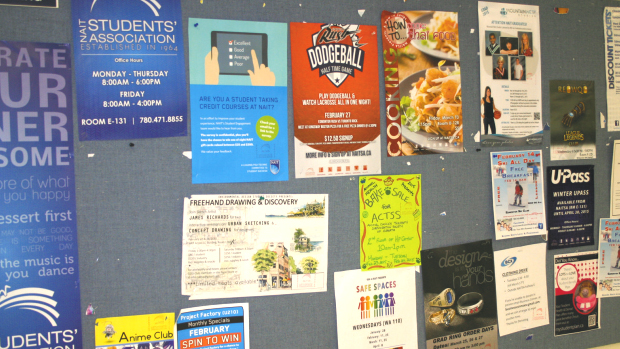For over a century, posters have been used by political parties, large corporations and numerous other groups and individuals wanting their message to be heard. However, over the past few decades, the digital age has begun taking over traditional methods of information delivery; for example the accessibility of newspapers on your phone. Every day, NAIT students walk past dozens of posters promoting events, opportunities and displaying valuable information they need to know. We set out to analyze whether this method of communication is still working or if posters are simply out of date.
At first glance, they all seem to have good colour and design, they are different enough from each other and the information they hold is relevant and generally important. However, we decided to look at the possible pitfalls of using posters. We initially noticed the issue of location. NAIT has various boards in key areas around the school, designated for all posters to be put up. The problem is there are so many posters at these locations, the boards become nothing more than a confusing collage of colours and information.
Next, we saw an issue with the posters themselves and how there is no way for students on the go to take that information with them. At most, some will take a photo of what they need to remember but even then the odds of them referring back to it are very slim. The biggest issue we noticed was during the first half of the lunch hour when we conducted the interviews. We watched as crowds and individuals walked past without so much as a glance towards the postings. The fact is, most people were too caught up in conversation or so focused on their phones they only looked up to avoid running into someone. Unfortunately for the art of posters, they are easy to ignore. There’s no physical interaction, no noise, no bells or whistles. They just stay quiet, tacked to the wall, their messages easily silenced. We then checked in with NAIT students to see what their thoughts were.
We interviewed different students as they passed one of the large posting boards just outside of the Common Market. We inquired whether or not they could tell us of a single poster they had walked by, any events they knew of happening around the school and whether or not they thought posters were still an effective marketing tool. We found that almost no one remembered a single poster they had just passed and most thought posters were not the best marketing tool. However, what surprised us was that most students were still getting the information they needed to know. The answer to this phenomenon is simple: frequency.
Although posters don’t make the average person stop in their tracks, they are always there. So much so, that the messages get stuck in your head without any conscious effort. Read anything enough and eventually you’ll memorize it. That is what makes posters so useful: they are physically posted in the hallways you pass through every day and, although you may only skim through the information once every so often as you pass by, you still see it. Once it is recognized by your brain you begin to notice it, pick it out more often and eventually, without even trying, remember that information. Although digital pop-up ads are effective, posters are not forced upon you. They are read by choice and remembered by habit. That is what makes posters a viable marketing tool and why they have not been replaced by a digital alternative.
By Mackenzie Roppelt
and Bryan Lentz





